Ruichen Chen
FP4DiT: Towards Effective Floating Point Quantization for Diffusion Transformers
Mar 19, 2025Abstract:Diffusion Models (DM) have revolutionized the text-to-image visual generation process. However, the large computational cost and model footprint of DMs hinders practical deployment, especially on edge devices. Post-training quantization (PTQ) is a lightweight method to alleviate these burdens without the need for training or fine-tuning. While recent DM PTQ methods achieve W4A8 on integer-based PTQ, two key limitations remain: First, while most existing DM PTQ methods evaluate on classical DMs like Stable Diffusion XL, 1.5 or earlier, which use convolutional U-Nets, newer Diffusion Transformer (DiT) models like the PixArt series, Hunyuan and others adopt fundamentally different transformer backbones to achieve superior image synthesis. Second, integer (INT) quantization is prevailing in DM PTQ but doesn't align well with the network weight and activation distribution, while Floating-Point Quantization (FPQ) is still under-investigated, yet it holds the potential to better align the weight and activation distributions in low-bit settings for DiT. In response, we introduce FP4DiT, a PTQ method that leverages FPQ to achieve W4A6 quantization. Specifically, we extend and generalize the Adaptive Rounding PTQ technique to adequately calibrate weight quantization for FPQ and demonstrate that DiT activations depend on input patch data, necessitating robust online activation quantization techniques. Experimental results demonstrate that FP4DiT outperforms integer-based PTQ at W4A6 and W4A8 precision and generates convincing visual content on PixArt-$\alpha$, PixArt-$\Sigma$ and Hunyuan in terms of several T2I metrics such as HPSv2 and CLIP.
Qua$^2$SeDiMo: Quantifiable Quantization Sensitivity of Diffusion Models
Dec 19, 2024



Abstract:Diffusion Models (DM) have democratized AI image generation through an iterative denoising process. Quantization is a major technique to alleviate the inference cost and reduce the size of DM denoiser networks. However, as denoisers evolve from variants of convolutional U-Nets toward newer Transformer architectures, it is of growing importance to understand the quantization sensitivity of different weight layers, operations and architecture types to performance. In this work, we address this challenge with Qua$^2$SeDiMo, a mixed-precision Post-Training Quantization framework that generates explainable insights on the cost-effectiveness of various model weight quantization methods for different denoiser operation types and block structures. We leverage these insights to make high-quality mixed-precision quantization decisions for a myriad of diffusion models ranging from foundational U-Nets to state-of-the-art Transformers. As a result, Qua$^2$SeDiMo can construct 3.4-bit, 3.9-bit, 3.65-bit and 3.7-bit weight quantization on PixArt-${\alpha}$, PixArt-${\Sigma}$, Hunyuan-DiT and SDXL, respectively. We further pair our weight-quantization configurations with 6-bit activation quantization and outperform existing approaches in terms of quantitative metrics and generative image quality.
 Add to Chrome
Add to Chrome Add to Firefox
Add to Firefox Add to Edge
Add to Edge